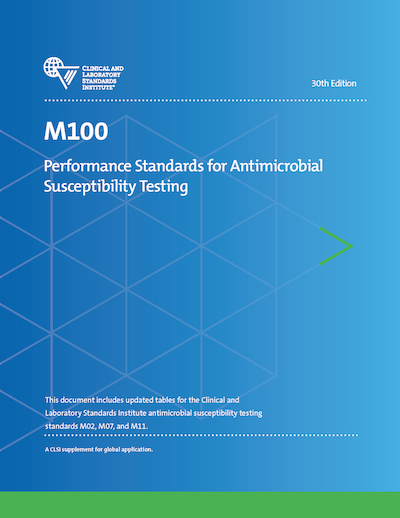How Using CLSI’s M100 Helps the Fight Against Antimicrobial Resistance
1/3/2020

In January of each year CLSI publishes M100 | Performance Standards for Antimicrobial Susceptibility Testing. M100 reports the antibiotic breakpoints that help medical laboratorians throughout the world provide accurate test results to health care providers. These breakpoints aid laboratorians in selecting the most appropriate and effective antimicrobial treatments for patients.
CLSI’s M100 is written by volunteer experts who develop, prescribe, and test antimicrobials, as well as those who report antimicrobial susceptibility test (AST) results. Multiple working groups within the CLSI Antimicrobial Susceptibility Testing Subcommittee address specific aspects of AST, such as determining which antimicrobials to consider for testing and reporting for a specific type of bacterium or assigning breakpoints to newer antimicrobial agents. The AST subcommittee is comprised of experts from health care, industry, and government. These experts include clinical microbiologists, pharmacists, and infectious disease specialists, as well as pharmaceutical and in vitro device manufacturers and statisticians. CLSI volunteers work together to ensure that the most up-to-date and useful information is available in the latest edition of M100.
Antibiotic resistance is one of the biggest public health challenges of our time. Each year in the US alone, at least 2.8 million people get an antibiotic-resistant infection, and more than 35,000 people die.1 Resistance occurs when an organism is no longer treatable by an antimicrobial that was once effective. While an infection can sometimes be treated with another antimicrobial, some organisms are completely resistant to all available treatments. Each new edition of M100 is adapted to reflect changes in treatment recommendations for resistant organisms.
Romney Humphries, PhD, D(ABMM) member of the CLSI Subcommittee on AST Testing, said of the changes in the 30th Edition, “In the 2020 edition of M100, we’ve taken the important step of setting, for the first time, colistin and polymyxin B breakpoints for the Enterobacterales. These breakpoints address a major global health need, with the emergence of more and more Gram-negative bacteria that are only susceptible to the polymyxin class of antibiotics. However, use of these drugs is not without substantial risk, as they are associated with high toxicity. As a result, the AST Subcommittee decided to designate only two interpretive categories for colistin: intermediate and resistant. The reason for this is that the clinical data did not support designating a “susceptible” category, which implies probable clinical success. Along with this breakpoint update, in M100, we describe two new methods for colistin testing: a disk broth elution method and an agar dilution method. Together, these two advances will allow laboratories to test and report these drugs.”
The 30th edition of M100 is available now, alone or in several package options with its companions, M02 and M07. M100 is also available in a convenient electronic subscription format, M100 Plus.
Reference
- CDC. Antibiotic/Antimicrobial Resistance. https://www.cdc.gov/drugresistance/index.html. Accessed January 3, 2020.
